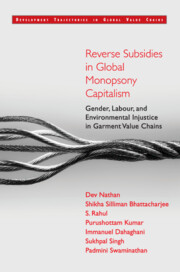 Reverse Subsidies in Global Monopsony Capitalism
Reverse Subsidies in Global Monopsony Capitalism 2 - Gender, Labour, and Environmental Injustice in Global Value Chains (GVCs)
Published online by Cambridge University Press: 21 January 2022
Summary
Introduction
This book deals with injustice in global production. Injustice means the absence of justice. Consequently, what we need to define is what constitutes global justice. The absence of the constituents of justice would then make for injustice. How do we identify the constituents of justice in global production? This book is about economic relations or politico-economic relations between actors and the outcomes they produce for gendered workers and the environment in the context of relations between suppliers and brands in what we have called global monopoly-cum-monopsony capitalism.
We define basic economic justice for gendered workers as the provision of the foundational capabilities for a dignified human life. These foundational capabilities are protected by labour standards, starting with the International Labour Organization's (ILO’s) core labour standards and extending to encompass living wages and bodily integrity. The acquisition of an input, whether labour power or environmental services, at prices below their cost of production or reproduction, constitutes a reverse subsidy that is unjust in that it deprives gendered workers of the requirements for a dignified human life and results in the deterioration of the environment. After dealing with economic justice for gendered workers, the chapter sets out the main features of environmental justice, in terms of raw material, manufacturing segments, and post-consumption waste.
In matters of justice, it is also necessary to identify actors responsible for injustice. The chapter then deals with whether we can hold brands or lead firms responsible for labour and environmental subsidies extracted at the level of supplier firms. Since brands or lead firms capture the majority of value added in the value chain, they should also be required to take major responsibility for the labour conditions in which this value is extracted. More importantly, however, brands or lead firms make choices in terms of supplier relations. They could choose to have a small number of suppliers with whom they have stable order relations, or, they could have short-term relations and unstable orders with a large number of suppliers. Their use of monopsony positions to create the latter type of short-term, unstable orders with myriad suppliers is a strategic choice. Since supplier relations are a choice rather than a compulsion, brands are directly responsible for how their terms of engagement with the suppliers impact workers and the environment in their value chains.
- Type
- Chapter
- Information
- Reverse Subsidies in Global Monopsony CapitalismGender, Labour, and Environmental Injustice in Garment Value Chains, pp. 26 - 47Publisher: Cambridge University PressPrint publication year: 2022


